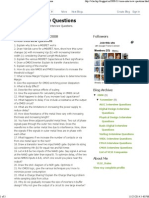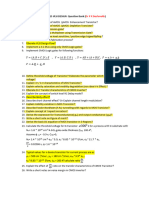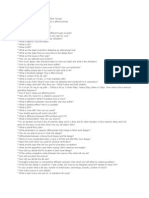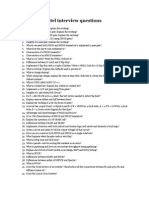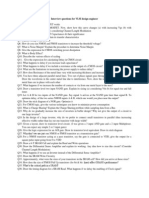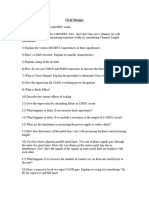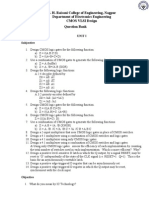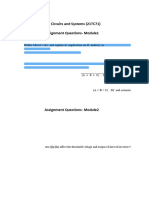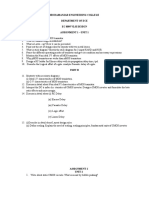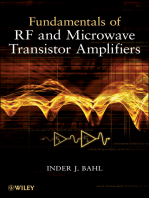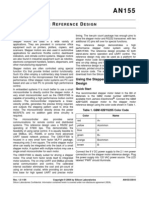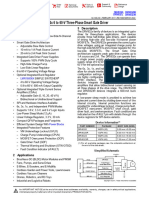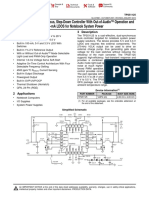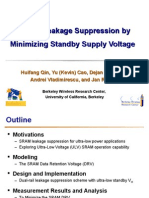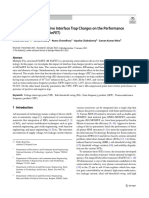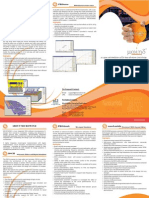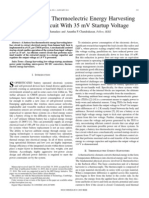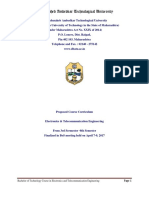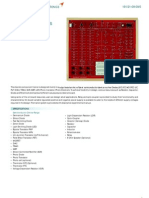VLSI
VLSI
Uploaded by
Nuniwal JyotiCopyright:
Available Formats
VLSI
VLSI
Uploaded by
Nuniwal JyotiOriginal Description:
Copyright
Available Formats
Share this document
Did you find this document useful?
Is this content inappropriate?
Copyright:
Available Formats
VLSI
VLSI
Uploaded by
Nuniwal JyotiCopyright:
Available Formats
VLSI
1. Draw the stick and circuit diagram of 2-input NAND gate using CMOS and n-MOS technology 2. Draw the stick and circuit diagram of 2-input NOR gate using CMOS and n-MOS technology 3. We have multiple instances in RTL (Register Transfer Language), do you doanything special during synthesis stage? 4. What is Channel length Modulation? 5. What is body effect? 6. What is latchup in CMOS design and ways to prevent it? 7. Difference between mealy and moore state machine? 8. What is CMOS Technology? 9. Give the advantages of CMOS IC. 10. What are four generations of Integration Circuits? 11. Why NMOS technology is preferred more than PMOS technology? 12. What are the different layers in MOS transistor? 13. What is Enhancement mode transistor? 14. What are the steps involved in manufacturing of IC? 15. What is meant by Epitaxy? 16. What are the processes involved in photo lithography? 17. What are the advantages and disadvantages of SOI process? 18. What are the various etching processes used in SOI process? 19. What is BiCMOS Technology? 20. What are the basic processing steps involved in BiCMOS process? 21. What is meant by interconnect? What are the types are of interconnect? 22. What is Stick diagram? 23. What are the uses of Stick diagram? 24. Compare between CMOS and bipolar technologies. 25. Define Threshold voltage in CMOS 26. What is Latch up? 27. What is demarcation line? 28. What are the two types of Layout design rules? 29. What is Lay-out design rule? 30. What are LVS and DRL tools? 31. What are the cells available in primitive library? 32. Draw the characteristics graph of enhancement mode of n-MOS. 33. What are the three modes in an enhancement MOS transistor? 34. How an Inversion layer is formed in MOS Transistor? 35. What are the different regions that can be defined in n-MOS depending uponthe voltages applied? 36. What is the formula for power dissipation for CMOS Inverter? 37. What is pull-down device? 38. How reliability of a VLSI circuit is related to itspower dissipation? 39. How environment is affected by the powerdissipation of VLSI circuits? 40. What are the commonly used conducting layersused in IC fabrication? 41. Show the basic structure of a MOS transistor. 42. What is the latch up problem that arises in bulkCMOS technology? How is it overcome? 43. Distinguish between the bulk CMOS technology withthe SoI technology fabrications. 44. What are the benefits of SOI technology relative toconventional bulk CMOS technology? 45. What are the basic assumptions of the fluid model? 46. Explain the function of a MOS transistor in thesaturation mode using fluid model. 47. Explain the function of a MOS transistor in thenonsaturation mode using the fluid model. 48. Explain the three modes of operation of a MOStransistors. 49. Explain the linear region of the I-V characteristic ofan nMOS transistor using the fluid model. 50. What is the threshold voltage of a MOS transistor? How itvaries with the body bias?
51. What is channel length modulation effect? How the voltagecurrent characteristics are affected because of this effect? 52. What is body effect? How does it influences the thresholdvoltage of a MOS transistor? 53. What is transconductance of a MOS transistor? Explain its rolein the operation of the transistor. 54. Explain the behaviour of anMOS transistor as a switch. 55. Explain the behaviour of a pMOS transistor as a switch. 56. How one nMOS and one pMOS transistor are combined tobehave like an ideal switch. 57. The input of a lightly loaded transmission gate is slowlychanges from HIGH level to LOW level. How the currents throughthe two transistors vary? 58. How its ON-resistance of a transmission gate changes as theinput varies from 0 V to Vdd, when the output has a light capacitiveload. 59. Draw the ideal characteristics of a CMOS inverterand compare it with the actual characteristics. 60. What is noise margin? Find out the noise margin from the actual characteristics of the inverter. 61. Compare the characteristics of the different typesof MOS inverters in terms of noise margin and powerdissipation. 62. What is the inversion voltage of an inverter? Findout the inversion voltage of a CMOS inverter. 63. How the inversion voltage is affected by the relativesizes of the nMOS and pMOS transistors of the CMOSinverter? 64. Find out the noise margin of a CMOS inverter. 65. How the noise margin is affected by voltagescaling? 66. What is the lower limit of supply voltage of a CMOSinverter. What happens if the supply voltage is furtherreduced? 67. What is sheet resistance? Find out the expressionof the resistance of rectangular sheet in terms of sheetresistance. 68. Find out the capacitance of a MOS capacitor. 69. Find out the expression of delay time of a CMOSinverter. 70. What are the various ways to reduce the delay timeof a CMOS inverter? 71. Explain the commonly used technique to estimatethe delay time of a CMOS inverter. 72. Justify the reason for not recommending more than 4 passtransistors to use in series in realizing logic circuits. 73. Draw the schematic diagram of an inverting super-buffer andexplain its operation. 74. Give the schematic diagram of a Bi-CMOS inverter. Explain its operation. 75. Compare the switching characteristics of a BiCMOSinverter with respect to that for static CMOS for different fan outconditions. 76. Prove that the delay of a series of pass transistors can bereduced from quardratic dependence to linear dependence on thenumber of transistors in series by inserting buffers at suitableintervals. 77. How the transfer characteristic of a CMOS NAND gate is affectedwith increase in fan-in? 78. How the transfer characteristic of a CMOS NOR gate is affectedwith increase in fan-in? 79. How switching characteristic of a CMOS NAND gate is affectedwith increase in fan-in? 80. How switching characteristic of a CMOS NOR gate is affectedwith increase in fan-in? 81. How noise margin of a CMOS NAND/NOR gate is affected with increase in fan-in? 82. For a complex/compound CMOS logic gate, how do you realizethe pull-up and the pull-down networks? 83. Give the two possible topologies AND-OR-INVERT AND-ORINVERT(AOI) and OR-ANDINVERT (OAI) to realize CMOS logicgate. Explain with an example. 84. Give the AOI and OAI realizations for the sum and carryfunctions of a full adder. 85. How do you realize pseudo nMOS logic circuits. Compare itsadvantage and disadvantages with respect to standard staticCMOS circuits. 86. In what way relay logic circuits differ from pass transistor logiccircuits? Why the output of a pass transistor circuit is not used as acontrol signal for the next stage? 87. What are the advantages and limitations of pass transistor logiccircuits? How the limitations are overcome? 88. Why is it necessary to insert a buffer after not more than fourpass transistors in cascade? 89. Why is it necessary to have swing restoration logic in passtransistor logic circuits? Explain its operation.
90. What is the sneak path problem of pass transistor logiccircuits? How sneak path is avoided in Universal Logic Module(ULM) based realization of pass transistor network. Illustrate withan example. 91. What are the key characteristics of MOS dynamic circuits? 92. Explain the basic operation of a 2-phase dynamic circuit? 93. How 2-phase clocks can be generated using inverters? 94. What makes dynamic CMOS circuits faster than static CMOScircuits? 95. Compare the sources of power dissipation between static CMOSand dynamic CMOS circuits? 96. What is charge leakage problem of dynamic CMOS circuits?How is it overcome? 97. What is charge sharing problem? How can it be overcome? 98. Explain the clock skew problem of dynamic CMOS circuits? 99. How clock skew problem is overcome in in domino CMOScircuits? 100. How charge sharing leads to power dissipation?
You might also like
- Intel. Interview QuestionsDocument3 pagesIntel. Interview QuestionsSatish MbNo ratings yet
- EDC Chapter Wise FormulasDocument12 pagesEDC Chapter Wise FormulasKisthan Leymar67% (6)
- Pocketpico Manual PDFDocument17 pagesPocketpico Manual PDFRichard BedellNo ratings yet
- VLSI Design Related Good QuestionsDocument2 pagesVLSI Design Related Good QuestionsGaurav PatelNo ratings yet
- Vlsi Interview QuestionsDocument10 pagesVlsi Interview Questionsnairkarthika0% (1)
- Interview QuesDocument12 pagesInterview Quesvlsi_asicNo ratings yet
- VLSI Assignment-Question BankDocument3 pagesVLSI Assignment-Question BankANUJ KALRANo ratings yet
- Vlsi Interview QuestionsDocument2 pagesVlsi Interview Questionsphani1259No ratings yet
- Vlsi Design Question Bank EEC 703Document10 pagesVlsi Design Question Bank EEC 703selvi0412No ratings yet
- Question BankDocument13 pagesQuestion BankRishi JhaNo ratings yet
- VLSI Design (Online Lectures) Assignment-1Document3 pagesVLSI Design (Online Lectures) Assignment-1TarushiNo ratings yet
- What Is STD Cells? How You Will Decide The Height of STD Cells? What Is Mean by Track What Is Mean by A Pitch?Document2 pagesWhat Is STD Cells? How You Will Decide The Height of STD Cells? What Is Mean by Track What Is Mean by A Pitch?Analog Layout100% (1)
- VLSI QuestionsDocument1 pageVLSI QuestionsHemant SaraswatNo ratings yet
- VLSI Placement PapersDocument5 pagesVLSI Placement PapersAsn RoyNo ratings yet
- Vlsi Viva QuestionsDocument5 pagesVlsi Viva QuestionsSree HariNo ratings yet
- Antenna Diode Vlsi Operation Positive ChargeDocument21 pagesAntenna Diode Vlsi Operation Positive ChargeNegin HashemiNo ratings yet
- General Digital Design Questions: How Do You Size NMOS and PMOS Transistors To Increase The Threshold Voltage?Document22 pagesGeneral Digital Design Questions: How Do You Size NMOS and PMOS Transistors To Increase The Threshold Voltage?Rahul VaddelliNo ratings yet
- Viva - Voce Model QuestionsDocument2 pagesViva - Voce Model QuestionsbharathiNo ratings yet
- Vlsi Design - Question BankDocument5 pagesVlsi Design - Question BankRamapriyavlsi0% (1)
- VLSI Interview Questions - RoutingDocument36 pagesVLSI Interview Questions - Routing3nadhs100% (1)
- ComosDocument36 pagesComosmelvin45No ratings yet
- CMOS Interview QuestionsDocument3 pagesCMOS Interview Questions3nadhsNo ratings yet
- Transistor: Vlsi Inter View QuestionsDocument3 pagesTransistor: Vlsi Inter View QuestionsHarini ManoharanNo ratings yet
- CMOS Q BankDocument3 pagesCMOS Q BankRathore Yuvraj SinghNo ratings yet
- Vlsi QDocument2 pagesVlsi QUma Maheswara Rao PNo ratings yet
- Ei2403 Vlsi DesignDocument10 pagesEi2403 Vlsi DesignSaravanan MathiNo ratings yet
- Inverter UnderstandingDocument1 pageInverter Understandingsudheerkumar1415No ratings yet
- vsli question bankDocument4 pagesvsli question bankakashmahajanam1603No ratings yet
- PD QuesDocument32 pagesPD Quessunkara naga hari prasadNo ratings yet
- Ec1401 Vlsi DesignDocument18 pagesEc1401 Vlsi Designanon-274152100% (3)
- 2 Mark Questions & AnswersDocument6 pages2 Mark Questions & AnswersMuthu KumarNo ratings yet
- Insights of An InverterDocument2 pagesInsights of An InverterArunKumarSainiNo ratings yet
- VLSID R20 Q BankDocument4 pagesVLSID R20 Q BankSATYA SRI LIKHITHA DUSANAPUDINo ratings yet
- Chapter - ICDocument9 pagesChapter - ICbelyalamgirNo ratings yet
- Vlsi Questions Unit WiseDocument3 pagesVlsi Questions Unit WisenaactitexcellenceNo ratings yet
- Ec 1401 - Vlsi DesignDocument22 pagesEc 1401 - Vlsi DesignPerumal NamasivayamNo ratings yet
- Intel Interview QuestionsDocument3 pagesIntel Interview QuestionsRuchi GujarathiNo ratings yet
- General Digital 1. General Digital Design Questions Design QuestionsDocument44 pagesGeneral Digital 1. General Digital Design Questions Design QuestionsAbdul KhaliqNo ratings yet
- VLSI DesignDocument4 pagesVLSI DesigntridhapukuNo ratings yet
- VLSI Interview QuestionsDocument19 pagesVLSI Interview QuestionssamNo ratings yet
- CMOS Assignment 1Document1 pageCMOS Assignment 1Dhaval ShuklaNo ratings yet
- Chapter Wise QuestionsDocument2 pagesChapter Wise QuestionshjjhghgNo ratings yet
- VLSI QuestionsDocument2 pagesVLSI QuestionsPrateek SharmaNo ratings yet
- Vlsi Very Imp QaDocument38 pagesVlsi Very Imp QaAjay Kumar MattupalliNo ratings yet
- VLSI DesignDocument8 pagesVLSI DesignigiriNo ratings yet
- CMOS VLSI Design - 102409020235 - 1Document7 pagesCMOS VLSI Design - 102409020235 - 1Raja Khurram ShahzadNo ratings yet
- Question Bank EEE-405Document3 pagesQuestion Bank EEE-405Mahidur RahmanNo ratings yet
- Ec2354/Vlsi Design Unit 1 - Cmos TechnologyDocument10 pagesEc2354/Vlsi Design Unit 1 - Cmos TechnologyPranav sharmaNo ratings yet
- Assignment QuestionsDocument1 pageAssignment Questionsb74cj9zy8sNo ratings yet
- Dronacharya College of Engineering, GR - Noida.: Q6.Explain Bridges, Routers, Gateways and Different LevelDocument4 pagesDronacharya College of Engineering, GR - Noida.: Q6.Explain Bridges, Routers, Gateways and Different Levelshyamsagar15No ratings yet
- VLSI AssignDocument5 pagesVLSI AssignSrideviasokanNo ratings yet
- CMOS Interview QuestionsDocument4 pagesCMOS Interview QuestionsLuca Reni100% (1)
- Signal Integrity: From High-Speed to Radiofrequency ApplicationsFrom EverandSignal Integrity: From High-Speed to Radiofrequency ApplicationsNo ratings yet
- Future Trends in Microelectronics: Journey into the UnknownFrom EverandFuture Trends in Microelectronics: Journey into the UnknownRating: 1 out of 5 stars1/5 (1)
- High-Performance D/A-Converters: Application to Digital TransceiversFrom EverandHigh-Performance D/A-Converters: Application to Digital TransceiversNo ratings yet
- Simple Arduino Inverter CircuitDocument11 pagesSimple Arduino Inverter CircuitPramilla100% (1)
- Stepper Motor Reference DesignDocument36 pagesStepper Motor Reference Designsreynoso68No ratings yet
- Mini Tesla CoilDocument35 pagesMini Tesla CoilThu ReinNo ratings yet
- DRV8323 Datasheet (1)Document111 pagesDRV8323 Datasheet (1)speedcoloradoNo ratings yet
- Tps 51125Document36 pagesTps 51125Anonymous imKfEGNo ratings yet
- Solid State Device ModelingDocument299 pagesSolid State Device ModelingDarwinNo ratings yet
- Study of Differential Amplifier Using CMOS: AbstractDocument5 pagesStudy of Differential Amplifier Using CMOS: AbstractNiranjan DaradeNo ratings yet
- SRAM Leakage Suppression by Minimizing Standby Supply VoltageDocument19 pagesSRAM Leakage Suppression by Minimizing Standby Supply Voltageapi-19668941No ratings yet
- Silicon On Insulator (SOI) Devices: Navakanta BhatDocument30 pagesSilicon On Insulator (SOI) Devices: Navakanta BhatVirendra MehtaNo ratings yet
- Memory Reverse IngDocument15 pagesMemory Reverse IngLuis D'ArdisNo ratings yet
- Effect of Positive/Negative Interface Trap Charges On The Performance of Multi Fin Finfet (M-Finfet)Document10 pagesEffect of Positive/Negative Interface Trap Charges On The Performance of Multi Fin Finfet (M-Finfet)Sandeep RoboticsNo ratings yet
- Understanding Power MOSFET Avalanche OperationDocument12 pagesUnderstanding Power MOSFET Avalanche OperationJorge Alberto Romero CoronaNo ratings yet
- DD Lab Manual PDFDocument337 pagesDD Lab Manual PDFAnkit SharmaNo ratings yet
- Microwind 3.5 BRDocument2 pagesMicrowind 3.5 BRammayi9845_930467904100% (1)
- EdcDocument17 pagesEdcchetan kapoorNo ratings yet
- Chandra KasanDocument9 pagesChandra KasanKumudu GamageNo ratings yet
- Analysis of Low Voltage Bulk-Driven High Swing Cascode Current Mirrors For Low Voltage ApplicationsDocument10 pagesAnalysis of Low Voltage Bulk-Driven High Swing Cascode Current Mirrors For Low Voltage ApplicationsIJRASETPublicationsNo ratings yet
- MIP2E2DMY PanasonicDocument3 pagesMIP2E2DMY Panasonicmomo nightcoreNo ratings yet
- B Tech-EXTCDocument164 pagesB Tech-EXTCANGEL 69No ratings yet
- COT-01 NewDocument2 pagesCOT-01 NewamitcrathodNo ratings yet
- Devicecraft: H-Bridge DC Motor Driver / Speed ControllerDocument26 pagesDevicecraft: H-Bridge DC Motor Driver / Speed ControllerGS OLDNo ratings yet
- Pcirf 3 3 Mos 2Document25 pagesPcirf 3 3 Mos 2Marius FerdyNo ratings yet
- Integrated Circuit Passive Components: ObjectiveDocument60 pagesIntegrated Circuit Passive Components: ObjectivemurganNo ratings yet
- Development of Mos-Fet Based Marx Generator With Self-Proved Gate PowerDocument5 pagesDevelopment of Mos-Fet Based Marx Generator With Self-Proved Gate PowerTRO SV UNDIPNo ratings yet
- Inverter Design: Compiled By: Prof.R.K.LambaDocument118 pagesInverter Design: Compiled By: Prof.R.K.LambaSamir TrivediNo ratings yet
- EE309 Notes 20 PDFDocument3 pagesEE309 Notes 20 PDFHassan FarssiNo ratings yet
- EKV v2.6 Parameter Extraction Tutorial Wladyslaw Grabinski: Geneva Modeling Center MotorolaDocument15 pagesEKV v2.6 Parameter Extraction Tutorial Wladyslaw Grabinski: Geneva Modeling Center MotorolaMohammad Ayatullah MaktoomNo ratings yet
- Irf 630Document7 pagesIrf 630Uriel EutimioNo ratings yet






















